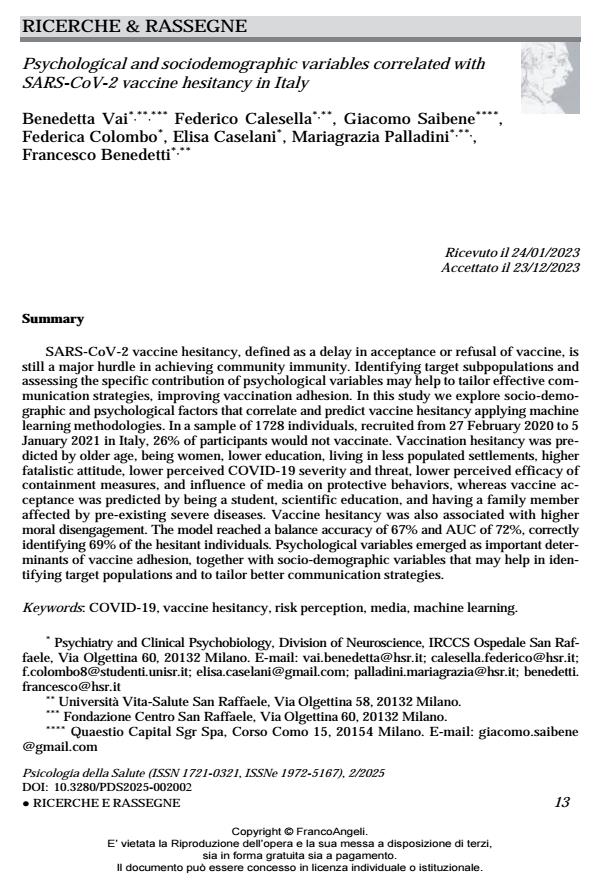Psychological and sociodemographic variables correlated with SARS-CoV-2 vaccine hesitancy in Italy
Titolo Rivista PSICOLOGIA DELLA SALUTE
Autori/Curatori Benedetta Vai, Federico Calesella, Giacomo Saibene, Federica Colombo, Elisa Caselani, Mariagrazia Palladini, Francesco Benedetti
Anno di pubblicazione 2025 Fascicolo 2025/2
Lingua Inglese Numero pagine 19 P. 13-31 Dimensione file 254 KB
DOI 10.3280/PDS2025-002002
Il DOI è il codice a barre della proprietà intellettuale: per saperne di più
clicca qui
Qui sotto puoi vedere in anteprima la prima pagina di questo articolo.
Se questo articolo ti interessa, lo puoi acquistare (e scaricare in formato pdf) seguendo le facili indicazioni per acquistare il download credit. Acquista Download Credits per scaricare questo Articolo in formato PDF

FrancoAngeli è membro della Publishers International Linking Association, Inc (PILA)associazione indipendente e non profit per facilitare (attraverso i servizi tecnologici implementati da CrossRef.org) l’accesso degli studiosi ai contenuti digitali nelle pubblicazioni professionali e scientifiche
SARS-CoV-2 vaccine hesitancy, defined as a delay in acceptance or refusal of vaccine, is still a major hurdle in achieving community immunity. Identifying target subpopulations and assessing the specific contribution of psychological variables may help to tailor effective communication strategies, improving vaccination adhesion. In this study we explore socio-demographic and psychological factors that correlate and predict vaccine hesitancy applying machine learning methodologies. In a sample of 1728 individuals, recruited from 27 February 2020 to 5 January 2021 in Italy, 26% of participants would not vaccinate. Vaccination hesitancy was predicted by older age, being women, lower education, living in less populated settlements, higher fatalistic attitude, lower perceived COVID-19 severity and threat, lower perceived efficacy of containment measures, and influence of media on protective behaviors, whereas vaccine acceptance was predicted by being a student, scientific education, and having a family member affected by pre-existing severe diseases. Vaccine hesitancy was also associated with higher moral disengagement. The model reached a balance accuracy of 67% and AUC of 72%, correctly identifying 69% of the hesitant individuals. Psychological variables emerged as important determinants of vaccine adhesion, together with socio-demographic variables that may help in identifying target populations and to tailor better communication strategies.
L’esitazione vaccinale per SARS-CoV-2, definita come un ritardo nell’adesione o il rifiuto del vaccino, identifica ancora a oggi un possibile ostalo nel controllo della diffusione epidemica. Identificare le sottopopolazioni maggiormente a rischio e valutare il contributo specifico di diverse variabili psicologiche può aiutare a personalizzare strategie di comunicazione efficaci e migliorare l’adesione vaccinale. In questo studio abbiamo valutato i fattori socio-demografici e psicologici che correlano e predicono l’esitazione vaccinale utilizzando metodologie di machine learning. Su 1728 individui, reclutati dal 27 febbraio 2020 al 5 gennaio 2021 in Italia, il 26% dei partecipanti non era incline a essere vaccinato. L’esitazione vaccinale era associata a una maggiore età, genere femminile, a un’istruzione inferiore, al vivere in centri abitativi meno popolati, a un atteggiamento fatalistico, a una ridotta percezione soggettiva di gravità e minaccia del COVID-19, a una minore percezione di efficacia delle misure di contenimento di ridurre il rischio di infezione e di influenza dei media sull’adozione di comportamenti protettivi. L’adesione al vaccino si associava invece allo status di studente, all’ aver ricevuto una educazione scientifica e all’avere un membro della famiglia affetto da gravi malattie fisiche preesistenti. L’esitazione vaccinale era anche associata a un maggiore disimpegno morale. Queste variabili hanno permesso di predire l’adesione vaccinale con un’accuratezza bilanciata del 67% e un’AUC del 72%, identificando correttamente il 69% degli individui esitanti. Non solo le variabili socio-demografiche, come genere, età e istruzione, emergono come importanti determinanti dell’adesione al vaccino, ma anche dimensioni psicologiche, come la percezione del rischio, il locus of control e il disimpegno morale, esercitano un ruolo cruciale nel modellare l’adesione al vaccino, aiutando a identificare popolazioni target che possono beneficiare di strategie di comunicazione mirate.
Parole chiave:COVID-19, esitazione vaccinale, percezione del rischio, media, machine learning.
Benedetta Vai, Federico Calesella, Giacomo Saibene, Federica Colombo, Elisa Caselani, Mariagrazia Palladini, Francesco Benedetti, Psychological and sociodemographic variables correlated with SARS-CoV-2 vaccine hesitancy in Italy in "PSICOLOGIA DELLA SALUTE" 2/2025, pp 13-31, DOI: 10.3280/PDS2025-002002